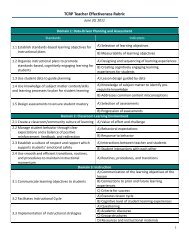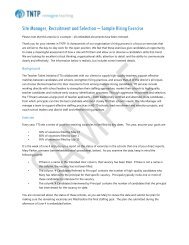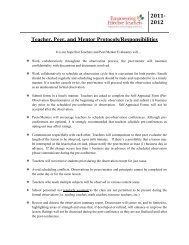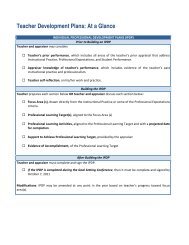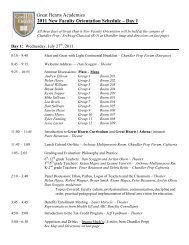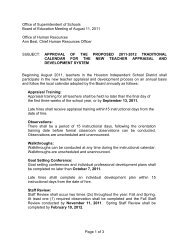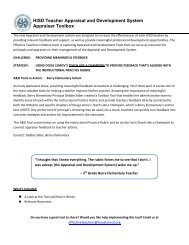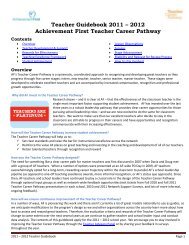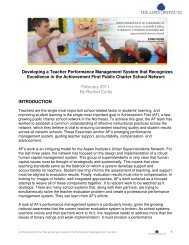Leadership Progression Roadmap Assistant Principal to ... - TNTP
Leadership Progression Roadmap Assistant Principal to ... - TNTP
Leadership Progression Roadmap Assistant Principal to ... - TNTP
Create successful ePaper yourself
Turn your PDF publications into a flip-book with our unique Google optimized e-Paper software.
DECISION‐MAKINGProcessesConsequencesSense of UrgencyCommunicatingDifficult ChoicesNovice Proficient MasterEstablishes clear decision making processes,communicating proactively about howdecisions will be made and who has input andensuring that decisions are made by individualsbest suited <strong>to</strong> make them.Communicates clearly about how decisionshave been made and uses transparentmethods for making decisions. Prefers <strong>to</strong>pdowndecision making. May not always usecollaborative decision making appropriately.Makes decisions that effectively address theimmediate needs of students, parents,teachers and staff.Focuses primarily on making the “best”possible decision and thus decisions may notalways be made on a timely basis.Explains decisions <strong>to</strong> staff, teachers, parents,the ED, and students when asked, but may notproactively reach out <strong>to</strong> stakeholder groups.Seeks alternatives before making difficultdecisions so that “no s<strong>to</strong>ne is left unturned”.Considers both the longer‐term andunintended consequences of potentialdecisions on the entire school community.Makes the right decision in a timely manner,using intuition, as well as data in the face ofambiguity.Timely and effectively conveys decisions <strong>to</strong>students, teachers, staff, the ED, and parentsand takes follow‐up actions <strong>to</strong> supportdecisions.Promptly makes and stands by controversialdecisions that benefit the organization. Sharesthe rationale for decisions with the <strong>Leadership</strong>Team, students, parents, teachers and staff,particularly when consensus cannot bereached.Effectively uses <strong>to</strong>p‐down decision making ORmore consensus‐based methods depending oncircumstances. Regularly solicits input from keystakeholders (including the ED, the <strong>Leadership</strong>Team, parents, teachers and students)regarding decision‐making processes.Effectively balances the short and long termconsequences of any decision. Helps the<strong>Leadership</strong> Team, teachers and staff see thelong‐ and short‐term implications of theirdecisions.Effectively balances time demands withconcerns for the quality and accuracy ofdecisions. Coaches <strong>Leadership</strong> Team members<strong>to</strong> avoid “analysis paralysis” when makingdecisions.Develops standardized procedures (often viathe <strong>Leadership</strong> Team) <strong>to</strong> ensure that alldecisions are communicated in a timely fashion<strong>to</strong> teachers, parents, students, the ED, andstaff using the most efficient and effectivecommunication methods.Anticipates when decisions might be difficultfor parents, students, teachers or staff <strong>to</strong>accept. Provides early warnings, significantinformation and demonstrates empathy andunderstanding when stakeholders have troubleaccepting a decision.PRINCIPALS 7




